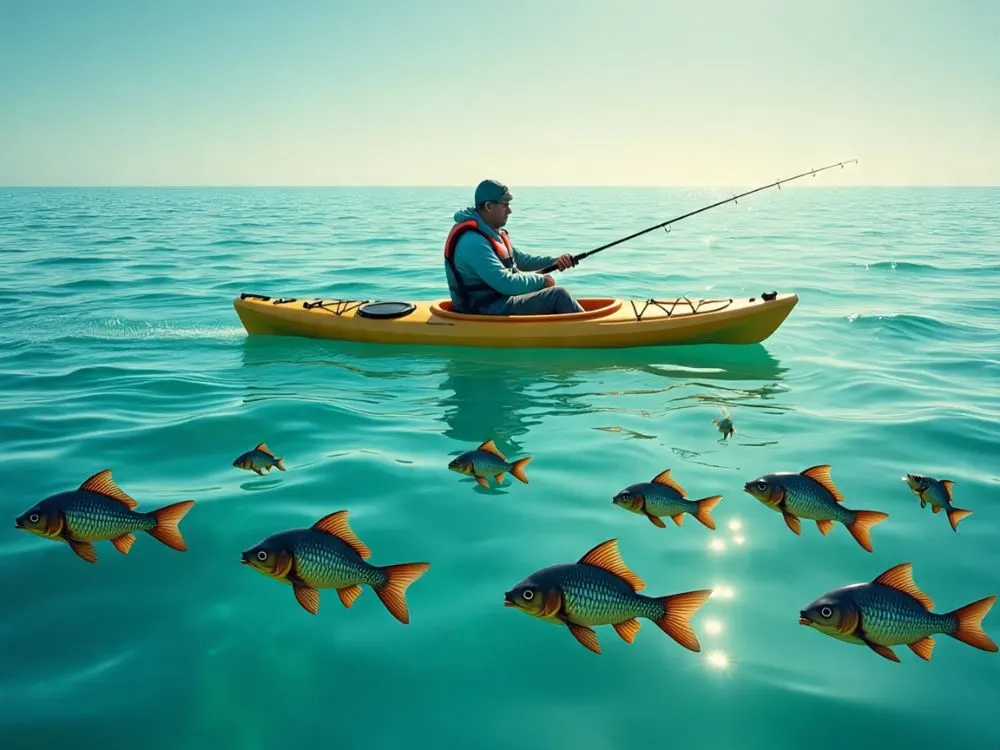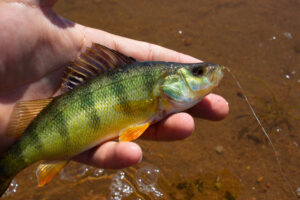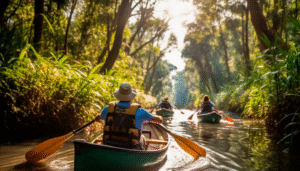Imagine gliding over turquoise waves, the salt air in your face, and the pull of a strong fish testing your line. This is ocean fishing from a kayak—a thrilling blend of adventure, skill, and serenity.
Whether you’re new to kayak fishing or looking to improve your offshore game, this guide is your go-to companion. We’ll explore gear, safety tips, techniques, and real-life stories to prepare you for an unforgettable ride on the water.
Why Try Ocean Kayak Fishing?
Ocean kayak fishing is not just about catching fish—it’s about the experience. You’re closer to the water, feeling every movement, every tug. It’s cheaper than a boat, easier to transport, and gives you access to fishing spots others can’t reach.
Benefits include:
- Affordability: No need for a big boat or expensive fuel.
- Stealth: Paddle quietly into schools of fish.
- Accessibility: Launch from beaches, jetties, or piers.
- Adventure: A personal encounter with the open sea.
First Things First: Choosing the Right Kayak
Not all kayaks are made for ocean fishing. You need a model built for stability, storage, and handling ocean conditions.
Key Features to Look For:
- Sit-on-top kayaks – Easier to get on/off and better drainage if waves crash over.
- Length (12–16 feet) – Longer kayaks track better in open water.
- Stability – Look for a wide hull (at least 30 inches).
- Storage – Dry hatches, bungee areas, and gear tracks.
Some top options include the Hobie Mirage Outback and Old Town Sportsman PDL.
Essential Gear for Kayak Ocean Fishing
Having the right gear can be the difference between a successful day and a frustrating one. Let’s cover the basics:
Fishing Gear:
- Saltwater rod and reel: Medium-heavy combo with corrosion-resistant parts.
- Tackle box: Include jigs, topwater plugs, and soft plastics.
- Fishfinder: GPS + sonar combo to locate fish and track your route.
Safety Equipment:
- Personal Flotation Device (PFD) – Always wear one.
- VHF Radio – For weather alerts and emergencies.
- Bilge pump or sponge – Remove water quickly.
- Whistle or horn – Required by U.S. Coast Guard.
Kayak Accessories:
- Anchor or drift chute: To stay in one spot.
- Rod holders: For trolling or hands-free fishing.
- Cooler or fish bag: Store your catch and keep it fresh.
Step-by-Step: How to Start Ocean Fishing from a Kayak
Step 1: Pick the Right Launch Spot
Start small. Choose protected coastal areas like bays, inlets, or harbors with calm waters. Sites like Dana Point, California or Tampa Bay, Florida are perfect for beginners.
Use the NOAA Marine Weather site to check ocean conditions before heading out.
Step 2: Launch Safely
- Always launch into oncoming waves, not sideways.
- Strap everything down—waves can flip gear overboard.
- Use a paddle leash so you don’t lose it if you tip.
Step 3: Navigate Smart
- Paddle past the breakers slowly and steadily.
- Watch for changing tides and currents using your tide chart.
- Stay within a mile or so from shore until you’re confident.
Step 4: Locate the Fish
Look for signs:
- Birds diving = baitfish below.
- Floating kelp beds = hiding spots for predators.
- Use your fishfinder or Navionics app for structure and depth.
Step 5: Fish with the Right Technique
Here are 3 proven methods:
- Trolling: Paddle slowly with lures trailing behind.
- Bottom fishing: Drop baited lines over reefs or structure.
- Casting and retrieving: Great for active species like mackerel or bluefish.
Best Fish to Target in American Waters
Depending on where you’re fishing, you can catch:
- California coast: Halibut, yellowtail, calico bass
- Florida coast: Snapper, grouper, kingfish, mahi-mahi
- Gulf Coast: Redfish, speckled trout, cobia
- Northeast: Striped bass, fluke, bluefish
Each fish has its own season and bag limits—check your state’s saltwater fishing regulations before heading out.
Real-Life Anecdote: “That Time I Hooked a Shark”
It was my third trip off the coast of Charleston. I was about half a mile out, just jigging near a ledge. Suddenly, my rod bent hard. I thought it was a big redfish—until the kayak jerked sideways. I looked down and saw a black fin slicing through the water.
I had hooked a 4-foot blacktip shark.
My heart was pounding. I cut the line and watched it swim off, adrenaline still surging. That day taught me two things: Always be ready for anything—and never underestimate what’s lurking beneath your kayak.
Important Safety Tips (Don’t Skip These!)
Ocean kayaking is fun but not without risk. Here’s how to stay safe:
Check the Forecast
Avoid winds over 10–15 mph or swells over 2–3 feet.
Use the Buddy System
Fish with a friend or at least let someone know your location and return time.
Dress for Immersion
Wear layers or a wetsuit in colder areas. You’ll be wet more often than not.
Practice Self-Rescue
Learn how to re-enter your kayak from the water. This is a must-know skill.
What to Pack in Your Dry Bag
Here’s a handy checklist:
- Sunscreen (reef-safe)
- Snacks and water
- Extra paddle
- First-aid kit
- Headlamp or flashlight
- Fishing license (digital copy is fine)
Kayak Fishing Etiquette
Yes, there are unspoken rules:
- Don’t crowd others—give at least 50 yards of space.
- Respect local wildlife and reefs.
- Pack out all your trash.
- Follow catch-and-release guidelines when needed.
Frequently Asked Questions
❓ Can beginners go kayak fishing in the ocean?
Absolutely—but start in calm, protected waters, and practice basic kayak handling first.
❓ How far can I go offshore in a kayak?
Most experts recommend staying within 2 miles of shore unless you’re highly experienced and have safety gear like a GPS and VHF radio.
❓ Do I need a special license?
Yes—check your state’s saltwater fishing license rules. Most offer affordable short-term or annual options.
Final Thoughts: The Freedom of the Sea
Ocean fishing from a kayak offers a unique blend of freedom, thrill, and connection to nature. It’s just you, your paddle, and the pull of the fish below. With a little preparation and a sense of adventure, anyone can enjoy this incredible sport.




